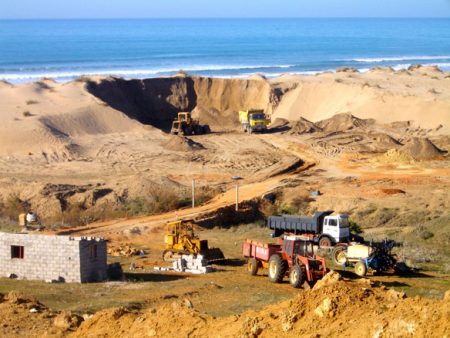Report on ‘Sand and Sustainability’ by UNEP 15/05/2019 – Posted in: Daily News – Tags: climate change, damage ecosystem, sand, Sand minning, sustainability, UNEP
“SAND AND SUSTAINABILITY” REPORT BY UNEP
For: Preliminary & Mains
Topics covered: UNEP Report- its findings, Problems & Solutions
News Flash
With the global demand for sand and gravel standing at 40 to 50 billion tonnes per year, a new report by UN Environment reveals that aggregate extraction in rivers has led to pollution, flooding, lowering of water aquifers and worsening drought occurrence.
The United Nations Environment Programme (UNEP) released a report, Sand and Sustainability: Finding new solutions for environmental governance of global sand resources, presents how shifting consumption patterns, growing populations, increasing urbanization and infrastructure development have increased demand for sand three-fold over the last two decades.
The report notes that China and India head the list of critical hotspots for sand extraction impacts in rivers, lakes and on coastlines.
Problems highlighted in Reports
- Sand consumption globally has been increasing and we are extracting it at rates exceeding natural replenishment rates.
- Sand and gravel are the second largest natural resources extracted and traded by volume after water, but among the least regulated.
- While 85% to 90% of global sand demand is met from quarries, and sand and gravel pits, the 10% to 15% extracted from rivers and sea shores is a severe concern due the environmental and social impacts.
- Damming and extraction have reduced sediment delivery from rivers to many coastal areas, leading to reduced deposits in river deltas and accelerated beach erosion.
Concern
- Their extraction often results in river and coastal erosion and threats to freshwater and marine fisheries and aquatic ecosystems, instability of river banks leading to increased flooding, and lowering of ground water levels.
- Most large rivers of the world have lost between half and 95% of their natural sand and gravel delivery to ocean.
- The damming of rivers for hydro-electricity production or irrigation is reducing the amount of sediment flowing downstream.
- This broken replenishment system exacerbates pressures on beaches already threatened by sea level rise and intensity of storm-waves induced by climate change, as well as coastal developments.”
- Other indirect consequences, like loss of local livelihoods— an ironic example is that construction in tourist destinations can lead to depletion of natural sand in the area, thereby making those very places unattractive — and safety risks for workers where the industry is not regulated.
What needs to be done?
Better spatial planning and reducing unnecessary construction — including speculative projects or those being done mainly for prestige — thereby making more efficient use of aggregates, investing in in infrastructure maintenance and retrofitting rather than the demolish and rebuild cycle, embracing alternative design and construction methods, even avoiding use of cement and concrete where possible, and using green infrastructure.
Among the studies on recycled and alternative substitute materials the report points to, are several from India, including oil palm shell, waste foundry sand, crushed tiles, granite powder, mine waste, bottom ash, and discarded rubber. It also cites the use in India of non-toxic municipal waste in road-building.
Governance and Way forward
At the policy level, the report suggests, is to strengthen standards and best practices to curb irresponsible extraction; invest in sand production and consumption measurement, monitoring and planning; and establish dialogue based on transparency and accountability.
Conclusion
- There is a need of urgent call for large-scale multipronged actions from global to local levels, involving public, private and civil society organisations.
- It is time to challenge the paradigm of infinite sand resources through constructive dialogue and solution-finding.
United Nations Environment ProgrammeThe United Nations Environment Programme (UN Environment) is the leading global environmental authority that sets the global environmental agenda, promotes the coherent implementation of the environmental dimension of sustainable development within the United Nations system, and serves as an authoritative advocate for the global environment. UNEP’s work encompasses: assessing global, regional and national environmental conditions and trends; developing international and national environmental instruments and; strengthening institutions for the wise management of the environment. |
Source: The Hindu
You can follow us on LinkedIn and for more updates related to UPSC IAS Preparation, Like our Facebook Page and subscribe our Diligent IAS Youtube Channel
Also Read Related Daily News
- Moderate Resolution Imaging Spectroradiometer (MODIS)
- WHO for Eliminating Trans Fats
- Double Asteroid Redirection Test (DART)

